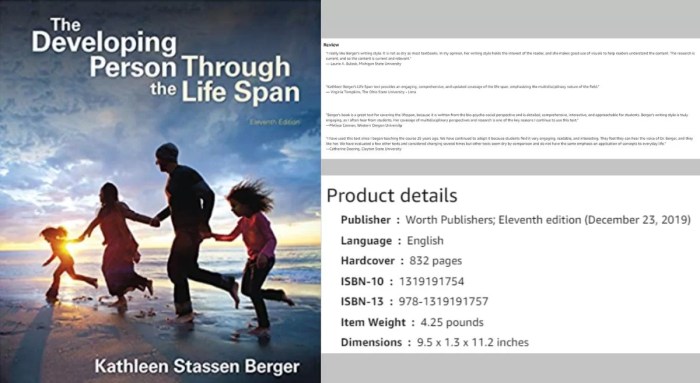The developing person through the lifespan 12th edition pdf – The Developing Person Through the Lifespan, 12th Edition PDF, offers a comprehensive and engaging exploration of human development from conception to late adulthood. This seminal work provides a deep understanding of the physical, cognitive, and psychosocial changes that occur throughout the lifespan, making it an invaluable resource for students, researchers, and practitioners in the field of human development.
With its authoritative and accessible writing style, The Developing Person Through the Lifespan, 12th Edition PDF, delves into the major theoretical perspectives on lifespan development, providing a solid foundation for understanding the complex interplay of biological, psychological, and social factors that shape human development.
1. The Developing Person
An Overview

Lifespan development encompasses the physical, cognitive, and psychosocial changes that occur throughout a person’s life. Major theoretical perspectives on lifespan development include the life-course perspective, which emphasizes the role of social and historical context, and the epigenetic perspective, which highlights the interaction between genes and the environment.
Physical changes include growth, motor development, and changes in sensory abilities. Cognitive changes involve the development of language, memory, and problem-solving skills. Psychosocial changes encompass the development of personality, self-concept, and relationships.
2. Prenatal Development: The Developing Person Through The Lifespan 12th Edition Pdf

Stages of Prenatal Development
- Germinal Stage:Conception to 2 weeks; formation of the zygote and embryo.
- Embryonic Stage:2 to 8 weeks; development of major organs and body systems.
- Fetal Stage:8 weeks to birth; growth and refinement of organs and body systems.
Factors Influencing Prenatal Development
- Maternal health and nutrition
- Environmental factors (e.g., toxins, stress)
- Genetic factors
Risks and Complications
- Birth defects
- Premature birth
- Low birth weight
3. Infancy and Early Childhood

Infancy and early childhood are characterized by rapid physical, cognitive, and psychosocial development.
Physical Changes
- Rapid growth in height and weight
- Development of motor skills (e.g., crawling, walking)
- Improved sensory abilities
Cognitive Changes
- Development of language skills
- Emergence of memory and problem-solving abilities
- Curiosity and exploration
Psychosocial Changes, The developing person through the lifespan 12th edition pdf
- Attachment to caregivers
- Development of self-awareness and self-regulation
- Emergence of play and social interactions
Importance of Early Childhood Experiences
Early childhood experiences have a profound impact on lifelong development, influencing physical health, cognitive abilities, and social and emotional well-being.
Popular Questions
What are the major theoretical perspectives on lifespan development?
The major theoretical perspectives on lifespan development include the life-course perspective, the sociocultural perspective, the evolutionary perspective, and the dynamic systems perspective.
What are the key physical, cognitive, and psychosocial changes that occur throughout the lifespan?
Key physical changes include growth and maturation, changes in body composition, and sensory and motor development. Key cognitive changes include the development of language, memory, and problem-solving skills. Key psychosocial changes include the development of self-concept, social relationships, and emotional regulation.
What are the potential risks and complications associated with prenatal development?
Potential risks and complications associated with prenatal development include birth defects, premature birth, and low birth weight. These risks can be influenced by factors such as maternal health, nutrition, and exposure to environmental toxins.
